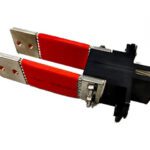Connector Degradation Mechanisms to Connector Testing
Dr. Bob Relates Connector Degradation Mechanisms to Connector Testing
New Connector Series Begins
The last article on loss of contact normal force completed the series on connector degradation mechanisms. (For completeness, the series included an introductory discussion of degradation mechanisms, two articles on corrosion—one on fretting corrosion and one on corrosion in noble metal contacts—an article on contact wear, and the final article on loss in contact normal force.
These are, of course, not the only degradation mechanisms active in connectors, but they are the most fundamental and most important considerations affecting the contact interface, arguably the most critical part of a connector. It has been said that a connector is simply two metal surfaces held together by supporting structures—a definition I endorse. Damage to the supporting structures, contact springs, and connector housings can certainly lead to connector failures, but such failures are not intrinsic or fundamental, and were not discussed due to their application dependence. There are an unlimited number of ways to damage connectors. While there are many reasons an understanding of fundamental connector degradation mechanisms is important to both connector users and connector manufacturers, there are two major reasons.
The first is that knowledge of degradation mechanisms provides insight into important decisions about connector design and material choices. For example, as a connector user, if you know your application environment is one where large and frequent variations in temperature will occur, an awareness of fretting corrosion as a degradation mechanism will influence your choice of a connector for that application. The corrosion aspect of fretting corrosion can be avoided by using a noble metal contact finish, e.g.. gold (but with an awareness of the limitations of gold flash in a fretting application). Alternatively, if you want to take advantage of the cost-effectiveness of tin-finished contacts, an understanding of the fretting aspect of fretting corrosion tells you that you must focus on a high-contact normal force connector to resist the driving forces of fretting motions—in this example differential thermal expansion mismatches in the connector system. Similarly, a connector manufacturer must be aware of the mechanisms of fretting corrosion, particularly in the design of tin-finished connectors, to enhance the mechanical stability of the contact interface against driving forces for fretting motions.
The second reason knowledge of connector degradation mechanisms is important is in validating connector design/performance through testing. Again, both connector users and connector manufacturers can derive benefits from such knowledge. Consider connector manufacturers first. It was stated that a connector designer must consider high-contact normal forces in tin-finished connectors to resist fretting motions. How much contact force is needed? A knowledge of connector degradation mechanisms, in this case, fretting corrosion and contact wear, helps to derive an answer to that question. The success of the design is verified by testing, thermal cycling, or mechanical disturbance for validation of resisting fretting motions, and mechanical wear evaluation to ensure finish integrity. The validation of such testing is generally documented in a product specification. A connector user can use knowledge of connector degradation mechanisms in assessing the relevance of the connector manufacturer’s product specification to the intended application. Was the delta T in the thermal cycling sufficient for the intended application? Were the mechanical shock conditions demanding enough? A well-conducted product specification qualification program will answer most of a connector user’s application conditions.
The next series of articles will expand on the previous discussion by relating connector degradation mechanism to connector testing. Some degradation mechanisms lend themselves to straightforward interpretation. Heat aging, to simulate stress relaxation, helps assess the effects of loss of contact normal force on connector performance, for example. Others, such as vibration to assess contact mechanical stability, are far from straightforward. The series will include discussions on developing a testing program, testing procedures for conditioning and evaluation, and experiences in connector testing.
I am pleased to say that I will have a partner in this series. Max Peel, retired president and current senior fellow of Contech Research, and I will be working together. I will do the Dr. Bob stuff and talk about fundamentals of some aspect of connector testing, and Max will do a follow-up discussion to lead you through the nitty-gritty of the topic I introduced, based on his long and varied experience at Contech.
- Nanocrystalline Silver Alloy Contact Finishes in Electronic Applications - April 6, 2015
- Nanocrystalline Silver Contact Platings - March 16, 2015
- Dr. Bob on Gold Flash Contact Finishes (and Max Peel) - September 22, 2014







